#Bengali children literature
Text

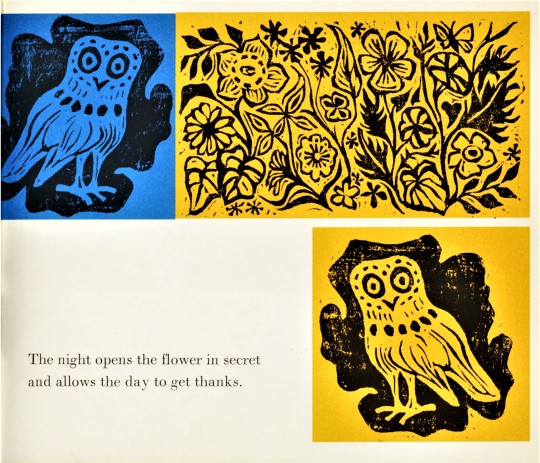


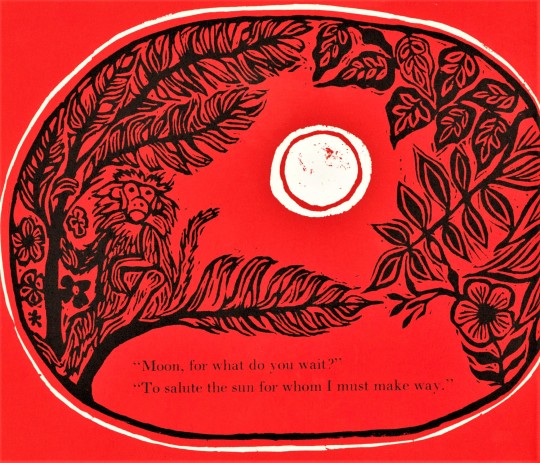
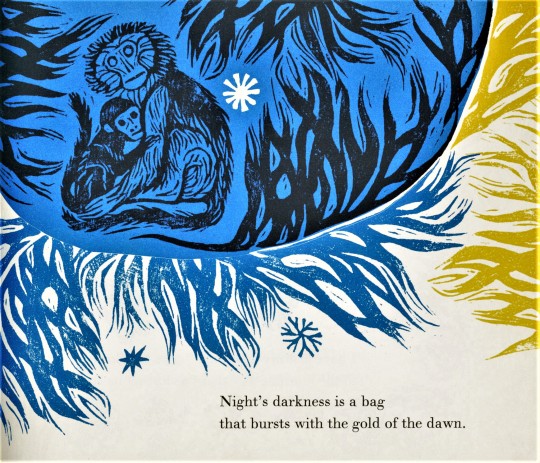



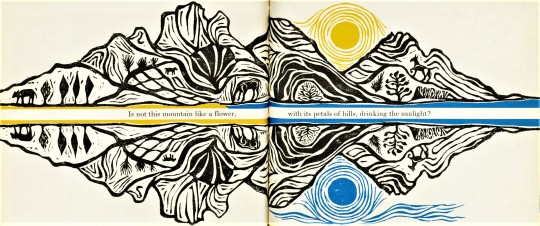
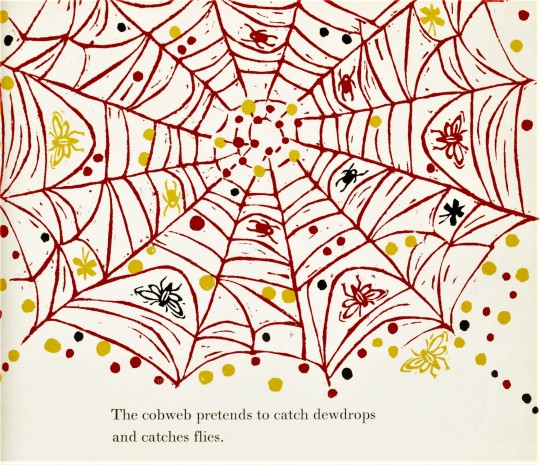

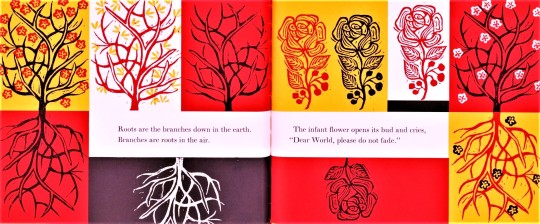

National Poets Day
On this National Poets Day, August 21, we celebrate the work of Bengali poet Rabindranath Tagore (1861-1941). Tagore began writing poetry as a child and remained committed throughout his life to exploring the natural and spiritual world through poetry and prose. He was known as the “Bard of Bengal” and in 1913 became the first non-European to be awarded the Nobel Prize in Literature for his collection of poetry Gitanjali.
Within the Special Collections we hold the first edition of Moon, For What Do You Wait?, a collection of Tagore poems from his 1916 publication Stray Birds which consisted of 326 verses. Published in 1967 by Atheneum, Moon, For What Do You Wait? was edited by Richard Lewis, director of the Touchstone Center for Children in New York City, with illustrations by award-winning artist and author Ashley Bryan (1923-2022). Lewis manages to whittle down Tagore’s lines without losing any of the imbued wonder and delight present in the original publication. Accompanied by Bryan’s bold illustrations, readers are encouraged to let their eyes wander over the pages, getting lost in prose and imagery.
View more poetry posts.
-- Jenna, Special Collections Graduate Intern
#National Poets Day#rabindranath tagore#moon for what do you wait#poets day#ashley bryan#richard lewis#atheneum#tagore#stray birds#poems#poetry#children's books#Historical Curriculum Collection
244 notes
·
View notes
Text
So I saw a lot of criticism by the Sanghis that Hindu mythology is not something one should write fanfiction about or that it's a religion, and therefore people shouldn't interpret and create stories of their own. But let me tell you something: the culture of fanfiction and re-interpretation of Hindu mythology is not at all new; it has been going on for decades.
So, as I said before in the blog, I am a Bengali, so most of the examples I will give are from Bengali literature. So Krishna is a huge part of these fandoms, and a lot of people write and draw things related to him. But this is definitely not a new thing; it has been going on since the time of Joydev's Geeta Govinda and Vidyapati's Vaishnav Padabali. There is a famous poem by Rabindranath Tagore:
শুধু বৈকুণ্ঠের তরে বৈষ্ণবের গান!
পূর্বরাগ, অনুরাগ, মান অভিমান,
অভিসার, প্রেমলীলা, বিরহ মিলন,
বৃন্দাবন-গাথা,—এই প্রণয়-স্বপন
শ্রাবণের শর্ব্বরীতে কালিন্দীর কূলে,
চারি চক্ষে চেয়ে দেখা কদম্বের মূলে
সরমে সম্ভ্রমে, —এ কি শুধু দেবতার!
Which translates to
"Are the songs of Vaishnav for Baikuntha alone?
Courting, attachment, sulkiness, sensitiveness,
Tryst, dalliances, parting and union, theme of,
The songs of Brindaban – this dream of love,
In the Shraban night on the bank of the Kalindi
The meeting of the four eyes under the Kadambatree
In blushing adoration - are these all for the Lord?
Most of the Vaishnav Padaboli and Radha Krishna Leela poets were very much influenced by their personal lives, which makes sense because they never really saw Radha Krishna with their own eyes, so obviously they need some kind of reference and muse for their works. For example, it is said that Vidyapati drew inspiration from the real relationship between a man and woman in that contemporary period for Radha and Krishna. He created the character of Radha from the very image of an adolescent, joyous young girl of that time period. His radha has a lot of human qualities. Then Chandidas, another important poet, apparently based Radha on his own lover, Rami. Rami was a lower-caste woman with whom Chandidas had an affair, but he couldn't marry her because it was not socially acceptable. Chandidas's Radha is portrayed as a sad woman, mourning for her lover from the very beginning, even before she meets Krishna, and it didn't change even when she was united with Krishna, as she was based on Rami, a woman who could never be with the man she loved due to society. Apart from them, the poets who composed Radha Krishna hymns during and after the rise of Sri Chaitanya in Bengal started including Chaitanya in their poetry. They wrote hymns dedicated to Chaitanya alongside Krishna; some of them even started crafting similar descriptions and personalities for both Radha and Chaitanya. It's from their narrative that Radha's love for Krishna symbolises devotees love for god; it was literally Krishna x Chaitanya. CHAITANYA FANFIC!!)
Apart from Vaishnav Padabali, we can also find examples of such works in Sakhta Padabali. For example, the whole concept of Durga pujo in Bengali is inspired by married women visiting their paternal family once a year with their children. The poets basically localised the mighty goddess Durga as a young girl married to Shiva, who is old and penniless. Several poets, like Ramprasad Sen and Kamalakanto (I don't remember his title), wrote hymns from the point of view of Menaka (Parvathi's mother) as she begged Giriraj (Parvati's father) to bring her daughter back. She chides Giriraj for marrying her young daughter to Shiva, who is old and penniless and roams in the crematorium with his ghost acquaintances. She worries about her young daughter suffering all alone in the Himalaya with no one to take care of. Isn't this also a kind of fanfiction? Where goddesses are made into normal women?
Also, if we talk about Mahabharat and the Ramayana, they also had fanfiction even before the rise of Wattpad and Tumblr. All the translations (except a few) adopted these epics in such a way that they could fit into their culture and contemporary society. It's a known fact that Tulsidas's Ramayan deviates a lot from the original one (Maya Sita, vegetarianism, etc.).
So in a way, it can be a retelling of some sort. So if we are shitting upon the culture of retelling and fanfiction, we should also talk about these examples, not only the modern ones. The truth is that retellings and fanfictions are necessary for these types of stories to survive. It makes sense that one modifies these age-old stories so they can fit into contemporary society. Every piece of ancient literature, be it the Greek epics, the Bible, or Hindu mythology, has its own share of retelling and fanfiction. These are not owned by a certain group of people; they don't have the right to gatekeep. People can and should explore these stories from their own point of view. They have the right to rewrite and retell the stories from a modern perspective. So before you chide a blog on Tumblr for writing Mahabharata-inspired fanfiction or incorrect quotes or bully them for writing a canonically incorrect ship,or critices them for writing self insert fic with Krishna stop and think for a second.
21 notes
·
View notes
Text
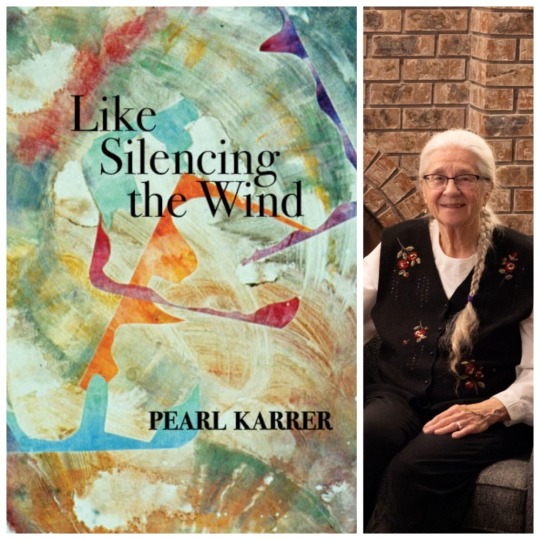
NEW FROM FINISHING LINE PRESS: Like Silencing the Wind by Pearl Karrer
On SALE now! Pre-order Price Guarantee: https://www.finishinglinepress.com/product/like-silencing-the-wind-by-pearl-karrer/
Like Silencing the Wind threads themes of conflict and war through #poems that affirm our shared #humanity. They cross barriers of time and continents, beginning with Rodin’s nude bronze of a helmet maker’s wife. Along the way a photograph evokes a French battle-field; a Gaustaus room, a German one. In Plivička, cascading lakes witness a policeman’s murder. War damaged houses lament their lost families. An Armenian girl in a Copper Age cave, a California vet with one leg, a bomb injured Boston Marathoner, Yucatan natives dreaming in thatch palapas, a Taureg nomad, all come to #life on the pages. Ending in Afghanistan, a murdered woman’s voice for freedom carries on the wind.
With a background in microbiology and music, Pearl Karrer currently teaches piano, exhibits art in juried shows and writes poetry. Her poems appear in many anthologies and journals such as Red Wheelbarrow, Slant, The Comstock Review. She has three chapbooks: Weathering (Slapering Hol Press), The Thorn Fence (Finishing Line Press) and Balanced Between Water and Sky (Finishing Line Press). After many years of editing, she has retired from the California Quarterly.
PRAISE FOR Like Silencing the Wind by Pearl Karrer
War pervades Pearl Karrer’s Like Silencing the Wind, passed down through family, a WWI nurse bearing the loss of her fiancé, a boy missing his older brother serving in WWII, children playing war games, a one-legged vet. Even the landscape contains memories of what happened there: trees slashed, waterfalls reminding the speaker of the beginnings of war in Croatia. Thoughts of war interrupt the enjoyment of berry picking, an autumn evening walk. Yet the poetry’s sensory language posits a way to survive the inevitable hurt. It insists that though we are all affected by what happens on the other side of the world we can bear some of the weight of it together.
–Stephanie Bloom Pressman
In Like Silencing the Wind, Pearl Karrer takes her inspiration from marvelously varied sources, offering images of natural wonder from the Plitviĉka waterfalls in Croatia to twin apricot moons rising over a Mayan landscape, each scene brimming with vivid details that bring even the inanimate to life. Karrer spins tales from family photographs in rural Montana, wartime memories of a farmhouse in Croatia, intimations of self in a Rodin sculpture, heart-rending scenes from Afghanistan, Syria, and Boston, ending with the story of a Bengali woman who crossed boundaries and worlds, like wind, with a voice that can’t be silenced. Here are reflections, echoes, reverberations across continents and millennia, each a mirror in which we see our humanity, its violence and tragedy, hope and creative resilience.
–Terry Ehret
Please share/repost #flpauthor #preorder #AwesomeCoverArt #read #poems #literature #poetry #life
#poetry#flp authors#preorder#flp#poets on tumblr#american poets#chapbook#chapbooks#finishing line press#small press
2 notes
·
View notes
Text
yess another tag game!! i love these sm thanks for tagging me @ashstfu !! love u <3<3
1. were you named after anyone?
not as far as i know
2. last time you cried?
it was fairly recently but i don't remember exactly. a week or two ago i think? because i remembered how happy & complete i felt that morning my ex best friend [who i may have been a little bit in love with] spun me around in the school garden & she was laughing & at that moment she was an angel on earth but then a few months later she spread rumours abt me like it was nothing & made sure i had no social life at school anymore... and i was just thinking what if forever is just two months. what happens when forever isn't just a word that feels so far away, like this love is going to last forever. &c &c
3. do you have children?
i am the child
4. do you play sports?
brown belt in karate !! also badminton sometimes
5. do you use sarcasm?
it comes naturally to me <3 my sarcasm peaks when i harbour no feelings towards the other person & do it just for fun <3
6. whats the first thing you notice about people
smile & mouth. hands & where they keep them.
7. whats your eye color?
dark brown eyes that don't sparkle in the sunlight !!
8. scary movies or happy endings?
why not both
9. talents?
idk. playing my guitar? loving & not knowing how to be loved back?
10. where were you born?
a hospital?? does this count as a question
11. what are your hobbies?
um reading, yearning, napping, longing, singing, listening to music, playing my guitar, horseriding & writing poetry that no one will read
12. do you have any pets?
nooo :( but i rly rly want a pet snake :((
13. how tall are you?
4’11. if you make fun of me i will cry
14. favorite school subjects?
english literature !! also bengali my love <3
15. dream job
anything to do with english literature!! also “local sweetheart loserbutch suspected to be gf of world’s most feared criminal” <3
2 notes
·
View notes
Text
Learning Bangla (Bengali) can be a rewarding experience, especially if you're interested in the culture, literature, or plan to travel or live in a Bengali-speaking region. Here’s a guide to help you get started:
1. Understand the Basics
Script: Bangla uses its own script, derived from Brahmi script. Start by learning the alphabet (known as "Borno Porichoy"). Focus on vowels ("swaroborno") and consonants ("banjonborno").
Pronunciation: Pay attention to pronunciation. Bangla has several sounds that might be new to non-native speakers, like retroflex consonants.
2. Use Language Learning Resources
Apps: Apps like Duolingo, Drops, or Mango Languages offer Bangla courses.
Websites:
Omniglot provides detailed information on Bangla scripts and phonetics.
Digital Dictionaries: Websites like Shabdkosh or Google Translate can help with word meanings and translations.
YouTube: There are numerous channels dedicated to teaching Bangla. Look for beginner series that cover basic grammar and vocabulary.
3. Enroll in a Course
Language Institutes: Some universities and language institutes offer Bangla courses.
Online Courses: Platforms like Coursera or Udemy sometimes offer Bengali language courses.
4. Practice Speaking and Listening
Language Exchange: Use platforms like Tandem or HelloTalk to practice with native speakers.
Media Consumption: Watch Bangla movies, listen to Bangla music, and follow Bangla news channels to get used to the language.
Social Media: Follow Bengali content creators or join Bengali language groups on Facebook or Reddit.
5. Read and Write Regularly
Children’s Books: Start with simple children’s books to build your reading skills.
Write Daily: Practice writing short paragraphs or even diary entries in Bangla.
Flashcards: Use flashcards (physical or apps like Anki) to memorize vocabulary.
6. Immerse Yourself
Cultural Immersion: Engage with Bengali culture. Participate in Bengali festivals, try Bengali cuisine, and connect with the Bengali community if possible.
Travel: If possible, spend time in Bangladesh or West Bengal, India, where Bangla is spoken widely.
7. Be Consistent and Patient
Daily Practice: Dedicate a specific amount of time each day to learning and practicing Bangla.
Set Goals: Set small, achievable goals like learning 10 new words a day or being able to hold a basic conversation by the end of the month.
8. Get a Tutor
If you want personalized guidance, consider hiring a Bangla tutor either locally or online through platforms like iTalki.
By following these steps, you can steadily improve your Bangla language skills. Remember that language learning is a gradual process, so consistency and practice are key.
0 notes
Text
How to Building a Daily Routine for Effective Self-Study to learn Bengali?
Learning Bengali on your own can be a rewarding adventure. But without structure, motivation can easily fade. To ensure steady progress, crafting a dedicated self-study routine is essential. Here's how to build one that optimizes your Bengali learning:
1. Define Your Goals & Learning Style:
Where do you see yourself in Bengali? Conversation, news, or literature? Setting clear goals guides your focus and keeps you motivated. Likewise, identify your learning style: auditory (listening), visual (flashcards), or kinesthetic (doing). Experiment with different methods to find your sweet spot.
2. Schedule & Embrace Variety:
Treat Bengali study like an important appointment. Block out dedicated time slots in your daily schedule, ideally at consistent times when you're most alert. Short, focused sessions are more effective than sporadic cramming.
Learning thrives on diversity. Incorporate a mix of activities such as grammar lessons, vocabulary building (flashcards, apps, labeling objects), and active practice like listening to Bengali music, podcasts, or audiobooks.
3. Dive Deeper & Make it Fun:
Supplement your core learning with reading practice: start with children's books or graded readers before moving on to news articles or short stories. Most importantly, find ways to integrate Bengali into your hobbies! Watch movies with subtitles, listen to Bengali music you enjoy, or find a language learning app with gamified features. Learning shouldn't feel like a chore!
4. Track Progress & Find Community:
Monitoring your progress is a fantastic motivator. Maintain a vocabulary journal, track completed lessons, or record yourself speaking Bengali to gauge your improvement. Celebrate your achievements, no matter how small!
Finally, connect with other Bengali learners online or in your local area. Sharing experiences and forming a support network can boost motivation and provide valuable insights.
Conclusion:
Crafting a personalized daily routine is the key to effective self-study. By setting clear goals, finding your learning style, incorporating a variety of engaging activities, and surrounding yourself with a supportive community, you'll be well on your way to unlocking the beauty of the Bengali language. Remember, consistency is key. So, grab your notebook, put on some Bengali tunes, and embark on your Bengali learning adventure!
#hindustanitongue#learn language#bollywood#language learning#bengali#bengali books#tamil online#bengali song#learn hindi online
0 notes
Text
My toxic trait is frothing at the mouth when people misuse "magical realism."
It is NOT fantasy tropes like wizards and ghosts in a realistic setting; as in it is not urban fantasy (genre fiction). It is extremely literary and specific. It is about unsettling strangeness that defies reality (or disrupts our understanding of reality, showing a reality in which the strange exists side by side the mundane), often taking elements from indigenous folklore and beliefs (as in indigenous to the setting of the story, heavily influenced by the history and culture).
👏educate yourselves👏
The term magic realism is broadly descriptive rather than critically rigorous, and Matthew Strecher (1999) defines it as "what happens when a highly detailed, realistic setting is invaded by something too strange to believe."[10] The term and its wide definition can often become confused, as many writers are categorized as magical realists. The term was influenced by a German and Italian painting style of the 1920s which were given the same name.[2] In The Art of Fiction, British novelist and critic David Lodge defines magic realism: "when marvellous and impossible events occur in what otherwise purports to be a realistic narrative—is an effect especially associated with contemporary Latin American fiction (for example the work of the Colombian novelist Gabriel García Márquez) but it is also encountered in novels from other continents, such as those of Günter Grass, Salman Rushdie and Milan Kundera. All these writers have lived through great historical convulsions and wrenching personal upheavals, which they feel cannot be adequately represented in a discourse of undisturbed realism", citing Kundera's 1979 novel The Book of Laughter and Forgetting as an exemplar."[11] Michiko Kakutani writes that "The transactions between the extraordinary and the mundane that occur in so much Latin American fiction are not merely a literary technique, but also a mirror of a reality in which the fantastic is frequently part of everyday life."[12] Magical realism often mixes history and fantasy, as in Salman Rushdie's Midnight's Children, in which the children born at midnight on August 15, 1947, the moment of India's independence, are telepathically linked.
...magical realism is often associated with Latin-American literature, including founders of the genre, particularly the authors Gabriel García Márquez, Isabel Allende, Jorge Luis Borges, Juan Rulfo, Miguel Ángel Asturias, Elena Garro, Mireya Robles, Rómulo Gallegos and Arturo Uslar Pietri. In English literature, its chief exponents include Neil Gaiman, Salman Rushdie, Alice Hoffman, Louis De Bernieres, Nick Joaquin, and Nicola Barker. In Bengali literature, prominent writers of magic realism include Nabarun Bhattacharya, Akhteruzzaman Elias, Shahidul Zahir, Jibanananda Das and Syed Waliullah. In Kannada literature, the writers Shivaram Karanth and Devanur Mahadeva have infused magical realism in their most prominent works. In Japanese literature, one of the most important authors of this genre is Haruki Murakami. In Chinese literature the best-known writer of the style is Mo Yan, the 2012 Nobel Prize laureate in Literature for his "hallucinatory realism". In Polish literature, magic realism is represented by Olga Tokarczuk, the 2018 Nobel Prize laureate in Literature.
https://en.m.wikipedia.org/wiki/Magic_realism
0 notes
Text
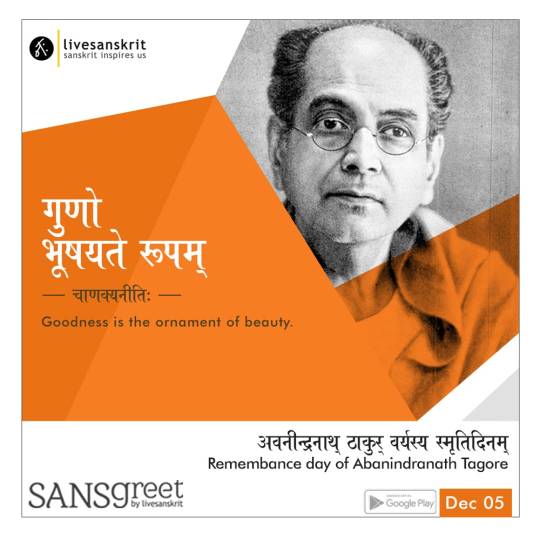
Send from Sansgreet Android App. Sanskrit greetings app from team @livesanskrit .
It's the first Android app for sending @sanskrit greetings. Download app from https://livesanskrit.com/sansgreet
Abanindranath Tagore.
Abanindranath Tagore CIE (7 August 1871 – 5 December 1951) was the principal artist and creator of the "Indian Society of Oriental Art". He was also the first major exponent of Swadeshi values in Indian art, thereby finding the influential Bengal school of art, which led to the development of modern Indian painting. He was also a noted writer, particularly for children. Popularly known as 'Aban Thakur', his books Rajkahini, Buro Angla, Nalak, and Khirer Putul were landmarks in Bengali language children's literature and art.
#sansgreet #sanskritgreetings #greetingsinsanskrit #sanskritquotes #sanskritthoughts #emergingsanskrit #sanskrittrends #trendsinsanskrit #livesanskrit #sanskritlanguage #sanskritlove #sanskritdailyquotes #sanskritdailythoughts #sanskrit #resanskrit #celebratingsanskrit #abanindranathtagore #abanindranath #tagore #artist #indianart #swadeshi #bengalschoolofart #calcutta #bengal #bengali #drawing #painting #writing #modernindianpainting
#greetingsinsanskrit#sanskritgreetings#sanskrittrends#trendsinsanskrit#livesanskrit#sanskrit#celebratingsanskrit
0 notes
Text

The Grand Tapestry of Ideas Unfurls: Jaipur Literature Festival Unveils Third List of Visionary Speakers
HIGHLIGHTS
● Third List of Speakers Announced: Third tranche of 25 speakers announced - The Festival announced its third list of 25 speakers out of over 300 speakers expected to attend the 2024 edition. The third list features Amod K. Kanth , Arun Maira, Badri Narayan, Daisy Rockwell, Daniel Hahn, Guillermo Rodríguez, Gurucharan Das, Ivy Ngeow, Kal Penn, Katherine Rundell, Koël Purie Rinchet, Louise Kennedy, Manju Kapur, Matthew Parker, Miranda Seymour, Monica Ali, Naushad Forbes, Peter Frankopan, Peter Moore, Philip J. Stern , Reshma Ruia, Richard Osman, Sanjay Jha , Sudha Murty, Yatindra Mishra
The annual and iconic Jaipur Literature Festival announced its third list of speakers for the much-awaited 17th edition, set to take place from February 1 - 5, 2024 at Hotel Clarks Amer, Jaipur. As the just-released list shows, the Festival will once again be a grand marathon of ideas between writers, thinkers, idealists, realists, visionaries, intellectuals, avant-garde practitioners and the iconoclasts, all of whom will engage in informed discussion, united by an abiding love for literature.
The third list of 25 speakers includes Amod K. Kanth, a prominent Indian social entrepreneur and activist with a parallel illustrious career as an IPS officer. His books include Khaki in Dust Storm: Police Diaries Volume-1’ and ‘Khaki on Broken Wings: Police Diaries Volume - 2; Arun Maira, former Member of India’s Planning Commission, Chairman of BCG India, Chairman of Save the Children India, and Chairman of Help Age International and author of the latest Shaping the Future: How to Be, Think, and Act in the New World; Badri Narayan, Sahitya Academy Award winning poet who’s poems have been translated into English, Bengali, Oriya, Malayalam, Urdu and many other Indian languages; Daisy Rockwell, artist and International Booker Prize winning translator, along with author Geetanjali Shree, for her translation of Shree’s Hindi novel, Tomb of Sand; Daniel Hahn, Booker International Prize shortlisted writer, editor, and translator, winner of the 2023 Ottaway Award for the Promotion of International Literature; Guillermo Rodríguez, author of When Mirrors Are Windows: A View of A.K. Ramanujan’s Poetics and co-editor of Journeys: A Poet’s Diary by A.K. Ramanujan and founding director of Casa de la India, a pioneering cultural centre in Spain; Gurucharan Das, former CEO of Procter & Gamble and author of his memoir Another Sort of Freedom; Ivy Ngeow, Malaysian-born, London-based author of The American Boyfriend, longlisted for the Avon x Mushens Entertainment Prize for Commercial Fiction Writers of Colour 2022.
The list continues with Kal Penn, actor, writer, former White House staff member and author of recently released memoir, 'You Can't Be Serious; Katherine Rundell, author of Super-Infinite, which won the Baillie Gifford Prize, and The Golden Mole and Other Vanishing Treasure; Koel Purie Rinchet, award-winning Indian actress, producer and writer of Clearly Invisible in Paris; Louise Kennedy, author of the Women's Prize shortlisted novel, Trespasses, which also won the McKitterick Prize, the An Post Irish Novel of the Year Award and the British Book Awards Debut Novel of the Year; Manju Kapur, Commonwealth Prize winning author of the novel Custody which was made into one of Balaji’s longest running serials; Matthew Parker author of The Sugar Barons and Goldeneye: Ian Fleming’s Jamaica and his recent, One Fine Day: Britain's Empire on the Brink; Biographer, novelist, memoir writer and critic Miranda Seymour, author of the award-winning memoir In My Father's House: Elegy for an Obsessive Love and recent biography I Used to Live Here Once: The Haunted Life of Jean Rhys; Monica Ali, bestselling author of five books: Brick Lane (Shortlisted for the 2003 Booker Prize), Alentejo Blue, In the Kitchen, Untold Story and Love Marriage.
The Festival will also feature Naushad Forbes, Co-Chairman of Forbes Marshall, India's leading Process and Energy Efficiency Company. His recent book is The Struggle and the Promise: Restoring India’s Potential; Peter Frankopan, Professor of Global History at Oxford University and author of The Silk Roads: A New History of the World; The New Silk Roads: The Present and Future of the World; and The Earth Transformed: an Untold History; Peter Moore, Sunday Times bestselling author of The Weather Experiment and Endeavour; Philip J. Stern, historian of the British Empire and the author of the award-winning book The Company-State and the latest Empire, Incorporated; Reshma Ruia, British Indian writer of the award-winning novel Still Lives; Richard Osman, author, producer and television presenter and bestselling writer of The Thursday Murder Club series; Sanjay Jha, Executive Director of Dale Carnegie and a former National Spokesperson for the Congress Party; Sudha Murty, Founder of Infosys Foundation, one of the first women engineers to start her career at TELCO (now Tata Motors), a prolific writer in English and Kannada; Yatindra Mishra, writer, columnist and cultural icon has worked extensively on the heritage of Indian music.
0 notes
Text
International School Library Month: Ideas to Celebrate This Month
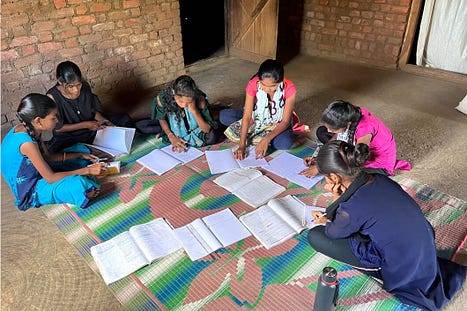
According to the data by World Population Review, Indians spend more time reading than anyone else, with an average of 10 hours and 42 minutes of reading per week. This shouldn’t come as a surprise, since India has a rich history of literature.
Right from the dawn of Indian civilization, books have been a huge part of Indians’ lives. Ancient epics like Mahabharata and Ramayana, along with classical writers like Rabindranath Tagore and Bankim Chandra Chatterjee, and even modern-day living legends like Arundhati Roy and Amish Tripathi, are all cherished by the people of India.
Indian literature covers various topics and stories, from experiences of marginalized communities to fiction, fantasy, mythology, romance, etc. Indians are even jumping into graphic novels, with writers like Naseer Ahmed, Saurabh Singh, Amruta Patil, and Sarnath Banerjee gaining prominence. Literature is not only limited to Hindi language but also regional languages like Malayalam, Bengali, Tamil, Marathi, Assamese, etc, and Western languages like English and French.
As India has such a widespread culture of literature, we should celebrate this International School Library Month and pass on this legacy of reading to future generations.
So, here are some ideas to celebrate International School Library Month:
Children’s Recommendation Display
Invite children in your locality to display their favorite books, along with a small write-up of why they love the said book. This would help other children to discover new books, genres, and authors and deepen their love for reading.
2. Display Stories Written by Children
What better way to carry on the legacy of Indian Literature than by giving emphasis to future writers? Encourage children to write their own stories and display them in your areas. Activities like these would help to boost the self-esteem of children and may give them impetus to pursue writing in the future.

You can also host an event where children swap their books, and allow them to bond over their favorite books. This could also be expanded to adults swapping books with children, rather than being limited to only children, as adults have read more in their lives, they can help children to explore more books.
4. Organize Book Donation
Host a book donation drive, where people can donate books to be given in local libraries. These drives can help children and people from marginalized communities to get access to more readers.
5. Invite an Author to Speak
If possible, you can also invite an author to speak on books and literature. Even professors of literature can be invited to conduct such sessions. These sessions will drive the zeal of children to study literature.
Along with its crowdfunding partner, Child Help Foundation, Filaantro has organized book drives and helped promote Child Help Foundation’s Quality Education programme. In total, Child Help Foundation and Filaantro have reached out to 4,86,141 children with its Quality Education programme.
Thank you for taking the time to read this blog. Make sure to share it with all your friends and family members.
#crowdfunding#fundraising#raise funds#filaantro#donate#education#nonprofits#charity#donations#volunteering
0 notes
Text
Promoting Multilingualism in Indian Education

Understanding Multilingualism in India's Classrooms
Multilingualism is a fascinating aspect of India's rich cultural heritage, and it plays a crucial role in classrooms across the country.
India is a linguistically diverse nation, with a vast array of languages spoken across its states and regions. From Hindi and Bengali to Tamil and Telugu, each language represents a unique cultural identity. At the best school in Kolkata, understanding the linguistic landscape of India is vital for comprehending the importance of multilingualism in classrooms.
Studies have shown that being multilingual offers cognitive benefits, such as enhanced problem-solving skills, improved memory, and increased creativity. In India's classrooms, where students often learn in multiple languages, these cognitive advantages can greatly contribute to their overall academic development.
Language is a powerful tool for preserving and promoting cultural heritage. Multilingual classrooms provide a platform for students to celebrate their native languages and cultures, fostering a sense of pride and belonging. By integrating diverse languages into the curriculum, top CBSE schools Kolkata help preserve the country's rich cultural tapestry.
Multilingualism in classrooms plays a pivotal role in promoting inclusive education. Students who are non-native speakers of the primary language of instruction can face barriers to learning. By incorporating multiple languages into the teaching process, educators from the best English medium schools near Garia can create an inclusive environment that caters to the diverse needs of all learners.
Multilingualism in India's classrooms is not just a linguistic phenomenon but a powerful tool for embracing diversity, promoting cognitive development, preserving cultural heritage, and fostering inclusive education. Recognizing the significance of multilingualism in education is crucial for nurturing well-rounded individuals who can thrive in a multilingual and multicultural society.
Why is multilingual education important in India?
Preserving Cultural Heritage
Multilingual education plays a vital role in preserving India's rich cultural heritage. By embracing and promoting regional languages, we ensure that the traditions, literature, and history intertwined within each language are passed down to future generations. This fosters a sense of pride and identity, strengthens cultural ties, and preserves India's diverse cultural tapestry.
Enhancing Cognitive Development
Studies have shown that multilingual education enhances cognitive development and critical thinking skills. When children are exposed to multiple languages, their brains are stimulated, resulting in improved memory, problem-solving abilities, and creativity. Multilingual education nurtures flexible thinking and adaptability, empowering individuals to navigate a rapidly changing global landscape.
Facilitating Effective Communication
In a linguistically diverse country like India, multilingual education promotes effective communication among individuals from different regions. By learning multiple languages, individuals can bridge linguistic barriers, fostering social cohesion and understanding. This paves the way for a harmonious society where people from diverse backgrounds can connect, collaborate, and thrive together.
Opening Doors to Opportunities
Proficiency in multiple languages opens doors to a plethora of opportunities. In a globalized world, multilingual individuals have a competitive edge in various fields, including business, tourism, translation, diplomacy, and academia. Multilingual education equips students from the best English medium schools near Garia with the necessary skills to engage with a broader audience, expand their horizons, and seize opportunities on both national and international platforms.
Implementation of a multilingual education system. NEP 2020: Promoting multilingualism in teaching and learning
Language serves as a bridge that connects individuals, cultures, and ideas. Embracing language diversity in education allows students to develop a deeper understanding and appreciation for different cultures, fostering empathy, and promoting global citizenship.
A multilingual education system offers numerous advantages. Firstly, it enhances cognitive abilities, as research has shown that bilingual individuals exhibit improved problem-solving skills and cognitive flexibility. Secondly, it promotes inclusivity and equal opportunities for students from diverse linguistic backgrounds. By providing education in their native languages, students can fully engage in the learning process and achieve academic success.
Implementing a multilingual education system comes with its own set of challenges. One of the key obstacles is the lack of resources and qualified teachers proficient in multiple languages. Additionally, resistance to change and the need for policy adjustments create further complications. However, at the best school in Kolkata, these challenges are overcome through strategic planning, investment in teacher training programs, and collaborations between educational institutions and language experts.
Several countries have successfully implemented multilingual education systems, offering valuable insights into effective practices. Investing in language immersion programs, fostering partnerships with local communities, and utilizing technology for language learning are essential strategies. Furthermore, creating a supportive and inclusive learning environment where all students feel valued contributes to the success of the system.
The National Education Policy (NEP) 2020 has a language policy that addresses all levels of education. The policy states that multilingual education should:
· Foster the use of language for conversation and language-based teaching
· Include all languages and dialects spoken in India, including tribal languages, sign languages, classical languages, and foreign languages
· Employ teachers with high levelel knowledge of a particular language
The top CBSE schools Kolkata believe that the three-language formula is important for preparing students for higher education. They also believe that it helps maintain India's rich linguistic heritage.
Multilingual education can be tailored to the needs and contexts of different learners and communities. It can also help students connect with their cultural heritage.
The implementation of a multilingual education system holds immense potential in nurturing culturally aware and linguistically competent individuals. By recognizing the power of language diversity, addressing challenges, and adopting best practices, we can create an inclusive educational landscape that prepares students for a globalized future.
0 notes
Text

Fragments of my Anecdotes, through The Namesake
Ashima having her shoes fit, in its correspondence with a foreign city and another man, had been utterly overwhelming for a woman, who had never stepped out of her own nation. The cultural heterogeneity made her feel like a fish out of water, every time she walked down the wide footpaths of America.
Jhumpa Lahiri, had done absolute justice to the word, “subtle”, in her creation of this novel, “Namesake”. It was a story of contrast of her own life, when she shares her nostalgia of division of her heart, into the two cities. As a nineteen years old reader of a woman, who left her homeland, all the narratives of the longings of the character of Ashima, reflected my persona, as if she was a mirror to my personality, one, with no scratch inscribed on it. The novel, touched upon so many perspectives of the society, be it loneliness or identity. The novel scarred my heart, forever, occurring to me, every time I scroll the social media and come across lines of the same, that my loved ones inside my house, snatched away my home from me too. One morning, my father, unlike Ashima’s, knocked upon my door with a sulken face, asking me for a favour. The instinctive benignity, took me off on an airplane a few months later, miles away from my own city, to the Southern part of our country, with an apartment in the heart of a cosmopolitan city.
Certainly, we see the motherly approach of Ashima of riding on a rickshaw, pulled by a man, that had been one of the colonial legacies, the city had held on to, in contrast with the Gogol’s refusal in availing the same. This reflected upon a fine line of identity that Ashima did not lose out on herself. Living in the western part of the Earth with her fondness for Bengali Literature, loomed the innocence of Ashima’s rather minimalism. The character of Ashima, brings out the woman in me, who would remember Tagore and Sukanta Bhattacharya’s expressions in her academic classes amidst all the rebukes, to keep her city engraved in her memory, unlike her contemporaries. It brings out that woman, who would run back to her homeland, her own city, and hover around the streets amidst the sultry summer afternoon and mild winter mornings, picking onto books from the College Street, or having phuchka, by the roadside. This part of the novel was somewhat sewn with my childhood. My revisits churn the reminiscence in the form of sweet, sorrowful nostalgia. I was nineteen; I walked around the oldest parts of my city, telling my lover about the story of the first time, I had watched a cinema in a cinema hall, named Metro. It does not exist anymore, neither does its hoarding. That day, we walked past tons of stores, polished with glimmering lights, attracting the lower-middle class of the city. He said, “This is the development you read in your academics”. I take him to one of the alleys, that is there near to this movie theatre and point out at a small store of pen, 75 years’ old, selling nibs of grace starting from Satyajit Ray, to the present generation too.
I ask him, “what about this person? Does he not worry about his children at home?” and this controversy covers our tête-à-tête, all the miles we wander and sadden. We differ a lot. His hustles have etched realism in him, but my privilege played in dichotomy.
"The state of the immigrant is one in which you live between worlds," explains Nair. Certainly, it showcases certain literary realism; the novel blends in simplistic approaches of relationships with between a husband and a wife, and a woman and Kolkata, how interconnected all the arenas of our lives are. Thousands of miles apart, the Queensboro Bridge was a metaphor to the Howrah Bridge that she could look at, through her window, and spend her longest and loneliest of hours. Yet, perhaps, she didn’t witness it enough, for all the years to be spent in a different world, altogether. Deaths, motherhood, marriages, adulthood, come about as pigeons carrying messages in leaflets that was a partial crux of the very novel, the Namesake of their son, Gogol, “we all came out of Gogol’s overcoat”. I did not. Life has eternally offered me with compulsive situations. At least, America had bridges to look at through windows; I had buildings with no resemblance.
A chain of sadness, with its quiet transformation into melancholy, was rhythmic, with the “abject unpredictability of life”. Being born into a tapestry of culture, was where I found myself around. The trams of Kolkata, the flower-markets, the tiresome vendors in the await of customers, the leftist rallies, were miserable to be devoid of, that resembled my life, until I settled outside of the very city of Kolkata. My flaming emotions were the riots, my city engulfed in, with my revisits, and my lover, the audience.
0 notes
Text
What are the names of the books written by Sukumar Ray?

What are the names of the books written by Sukumar Ray?Sukumar Ray (1887-1923) was a renowned Bengali writer, poet, and playwright from the early 20th century. He is considered one of the pioneers of modern children’s literature in Bengali and is highly regarded for his wit, humor, and innovative use of language. Abol Tabol (The Weird and the Absurd) Pagla Dashu Khai-Khai (Eat-Eat) Heshoram Hushiyarer …
Read the full article
0 notes
Text
Chhele Vulano Chhara by Nityananda Binod Goswami pdf
Chhele Vulano Chhara by Nityananda Binod Goswami, Bengali ebook pdf
These rhymes have been compiled targeting all Bengali children. This branch of folk literature is very attractive not only to children but also to adults. Bengali rhymes are funny and also have a literary quality. The movement of words is influenced by contemporary events. Bengali rhymes are a way of developing Bengali literary…
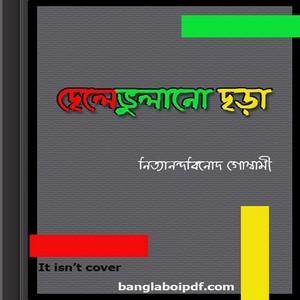
View On WordPress
0 notes
Text
Introducing Digital Civics and Cyber Security in Himachal Schools

The digital age has brought with it numerous benefits, but it has also given rise to a new set of challenges. Cybercrime is one of the most pressing concerns in today's world. With more and more people accessing the internet, the threat of cybercrime has increased manifold. Children are particularly vulnerable to online dangers, which is why it is essential to educate them about digital civics and cyber security.
As per reports, a proposal has been sent by the Himachal Pradesh Police to the Education Department of the Hill State, suggesting the inclusion of digital civics and cyber security in the school curriculum to better equip children in dealing with the increasing threats of the online world. The police department of Himachal Pradesh has taken a serious note of the deteriorating situation and has urged the state government to introduce chapters on cyber safety and digital civics in school curriculum, to create awareness on cybercrimes and safeguard the younger generations in the digital world.
The Himachal Pradesh Police have stressed the need to sensitize school-going children about cybercrimes, as they start using computers and mobile phones at an early age. According to a letter addressed to the principal secretary (education) of the state government, cybercrime has no boundaries and is characterized by fast-paced technological changes, making it necessary to spread awareness about it.
Also Read: Kashmiri Brother-in-Law could not show Kamal, and pressure on Nagpur police failed
The police have been regularly holding awareness drives in schools and colleges to appraise students about cyber crimes, but campaigns are essential as "precaution is better than cure." Officials noted a manifold increase in cybercrime and threats, with vulnerable people ill-equipped to deal with them. The police have cited several examples of frauds and cheating cases in the wake of increased mobile and digital payments. The state's police lodged 923 cyber offence complaints in 2017, but that number rose to 6,207 in 2021.
Common cyber crimes include phishing scams, identity theft, online harassment, cyber-stalking, invasion of privacy, debit/credit card fraud, ATM fraud, and pornography, with a significant rise witnessed in cybercrime against women and children.
Superintendent of Police (cybercrime) Rohit Malpani revealed that 10 to 15% of the cyber complaints directly or indirectly involve children, and this percentage rises to over 30% in social media-related complaints.
Also Read: Cybercrime in Nagpur - Cyber Blackmailer Couple Arrested in Pune for Extorting Money
The proposal for incorporating cyber security and digital civics lessons in schools provides examples of initiatives taken by the Central Board of Secondary Education (CBSE) and the Indian Certificate for Secondary Education (ICSE). The CBSE had conducted webinars for students and teachers, which allowed students to choose the language of their choice for cyber awareness lessons, including English, Hindi, Tamil, Bengali, Punjabi, Assamese, Odiya, Gujarati, Malayalam and Marathi.
In their communication to the education department, the police mentioned literature developed by various organizations such as the CBSE, ICSE, Reserve Bank of India, and the Union Ministry of Home Affairs. The literature included books like the cyber safety manual for children, cyber safety booklet for children, a booklet on modus operandi of financial fraudsters, a handbook on cyber safety for adolescents/students, and a book on children and cyber safety.
In conclusion, the proposal to introduce cyber safety and digital civics lessons in schools of Himachal Pradesh is a much-needed step towards ensuring the safety of children in the digital world. The initiative will help inculcate a sense of responsibility among the students towards the use of technology, and make them aware of the potential dangers of the online world.
Source: https://www.the420.in/proposal-to-introduce-digital-civics-and-cyber-security-lessons-in-schools-in-himachal-pradesh/
0 notes
Text
Sandesh Eksho Golpo Eksho Bengali book pdf
Sandesh Eksho Golpo Eksho, Bengali book pdfebook name- ‘Sandesh Eksho Golpo Eksho’Written by- VariousEdited by- Ashok Kumar Mitra and Prasadranjan RoyBook genre- Stories collectionFile format- PDFPDF Size- 6 MbPages- 586Quality- HQ, without any watermark, clickable table of contents
The rich form of Bengali children’s literature that we see today is due to the special contribution of Sandesh…

View On WordPress
0 notes